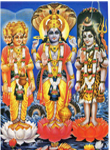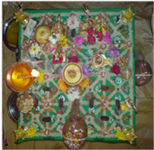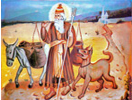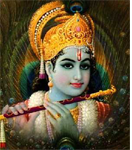Article by Sant Bapu
Many times I have been requested by devotees of Ramapir to explain what Maha Dharma is and its relationship with Ramapir. By the grace of Baba, my sadguru and beloved father Param Pujya Shri Ramdas Bapu I had the opportunity to address Baba's devotees in London and Birmingham on this subject. I explained in simple terms what I understand of Maha Dharma.
In order to understand Maha Dharma one should try to define what Hindu Dharma is. Hindu Dharma is the oldest religion in the world. The sub-religions like Buddhism, Jainism and Sikhism has evolved from Hinduism. It has been further divided into various sects like Shiv-ism, Shakti-ism, Vishnu-ism, Swaminarayan-ism and a new sect which has been in existence for around last fifty years called Krishna Consciousness. Hindu Dharma is ancient, hence Sanatan. The devotees of Maha Dharma strongly believe this to be the root of the giant tree of Hindu religion.

What is Hindu religion? The subject itself is as vast as the universe which has no cosmic boundaries. How can it be explained to non-Hindus? - Lord Krishna has given us various theories in Shrimad Bhagwad Geeta and our Mahatmas, Spiritual Masters, Scholars and Scriptures have come up with different schools of thoughts.
To me, Ajanma (unborn) Shiv-tatva (or immanent life force) through its own Echchha-shakti (will power) instigated three energetic facets which might be termed Creation, Survival and Destruction. We could personalise this analogy by calling Brahma, Vishnu and Mahesh (Shiva) as individual managers in charge of organising their own domains - Brahma creates, Vishnu maintains life while Mahesh keeps the balance of nature by destruction.
So this, in my opinion, is the very essence of Hinduism. Everything you see, hear, touch, feel and experience is Brahma's creation nurtured by Vishnu and brought to an end by Mahesh.

The next step is to know what is Maha Dharma. Maha Dharma can be defined or interpreted as the Main Duty that we should have towards all creations of god whether it be species of any kind or even the environment, with care being the main purpose. However Maha Dharma stresses ones duty towards another human being, as we believe ourselves to be the most advanced of all god's creations.
Maha Dharma can be explained in various ways but the basic principle or understanding remains the same despite bearing different names, having other definitions, and/or evolutionary practices.
We are taught that the Atma, (or soul) is a small, separate part of the Almighty known as the Paramatma. Upon demise, the Atma reunites with the Paramatma and becomes one. One should therefore not violate or disturb other sentient beings in any circumstance One should try to develop a kind nature, treat all as equals and work towards liberation of the soul, that is, Mukti or Moksha.

Whenever the devotees of Ramapir attend Paath- Pooja ceremony, Maha Jyot (eternal flame) will be present in the centre of the Paath where all will see or do Darshan. The Jyoti alight inside the human being is the same Jyoti or Paramatma exists in all living creations of Brahma. This too is Maha Dharma and is one of the ways to achieve Moksha (Liberation). The practice of Ramapir's Paath and following his commandments is also a way to achieve Mukti. This, in brief, is Maha Dharma in its simplest and literal sense.
Maha Dharma is known by various names, namely, Maha, Nijar, Nijya, Nij, or Mul Panth or Mul Marg or Mul Dharma or Bij Dharma. All these names mean, The Main Road or The Great Way or The High Way.
The word Nijar means having controlled, suppressed or killed sexual desires and a person who has done this is a Nijari. It is said that those who have this quality can achieve eternal bliss by indulging in Bhakti (devotion).
The word nij or Nijya means to know one's true self or have self-realisation of Atma and its relationship to Paramatma. A human being is made in the image of God, hence Atma or Soul is in itself a form of Paramamta and must be treated as the highest form of Shiv-Tatva or element and be appreciated and well respected. Therefore, Atma, whether it is of an insect or a human being must not be hurt or ill treated in any way.
Since ancient times Maha Dharma has been in existence and this is when only Brahmins and some of Vaishyas, Kshtriyas and Shudras were educated and of the rest most were illiterate and it was for them the acharyas laid down Maha Dharma in the form of the practice of Paath Pooja to achieve Mukti.

However, at first this Dharma was practised among the great sages like Guru Dattatraya (Head of Navnath), Matsyendranath, Jalandharnath, Guru Gorakhnath, Vashishtha, Vishwamitra, Agatsya, Markund, Parasar, Ramanuj and many more. The Rajputs like King Prahlad, Harishchandra, Yudhishthir and Bali and many more practised Nijya Dharma.
Ancient devotional Bhajans (songs) disclose that in every Yug (Era) this Nijya Dharma was being practised and many achieved Nirvana. In present times it can be practised through Bhakti which in itself is Yoga as recited by Lord Krishna in Shrimada Bhagvada Geeta.
Maha Dharma also includes all forms of Yogas described in Geeta, namely, Vishad Yoga (time to repent), Sankhya Yoga (the one born is destined to die, except his/her atma), Gyana Yoga (all mental and bodily activities are set aside, differences and partiality), Karma Yoga (to act with no desire to reap fruits of one's deeds), Moksha and Sanyas Yoga (act of renounciation of cosmic pleasures).

History holds that in this field of Maha Dharma, over 600 years ago, Lord Krishna reincarnated as Shree Ramdevji Maharaj in Pokran in Rajasthan. At the time, due to the Moghul empire, Hindus were not allowed to practice Hinduism freely.
Hence Maha Dharma was practised behind closed doors but discrimination still existed among the four castes Brahmins, Kshatriyas, Vaishyas and Shudras. Shree Ramdev Baba brought about the awareness, oneness and unity by bringing people of all castes together under one roof in Paath Pooja of Maha Dharma. He also eliminated many evil practices.
In his time many achieved Nirvana. Some of these include Harji Bhatti, Harbhuji, Dalibai, Ravat Ransinh, Jesal and Toral, Rupande and Maldevji, Lakhmo Maali and Khimliyo Kotwal, Baba Selansinh, Devayat Pandit, Sati Devalde, Devtankhi Luhar, Dada Mekran Kapdee of Kutchh, Sant Devidas of Parab, the bhakta mandal of Panchal (Apa Mepa, Apa Jadra, Apa Rata, Apa Giga, Laxman Bhagat, Shree Shamji Bhagat) and countless more.

Bhagwan Shree Ramdevji Maharaj laid down the basics of Maha Dharma in his 24 Farmaans (Commandments) at the time of his Samadhi. Over the last six centuries Maha Dharma has picked up its momentum and spread to various parts of India, particularly in Rajasthan, Gujarat, Bengal and recently in Goa.
In the last eighty years it has travelled to various parts of the world, for example East and South Africa and in the sixties it arrived in the United Kingdom with the flow of Gujaratis from the East Africa where the pioneer Guru was Param Pujya Sant Shiromani Shree Ramdas Bapu. In the last twenty years the followers of Ramapir have reached USA/Canada, Australia and New Zealand.
Those devotees of Ramapir and the followers of Maha Dharma, are, in my opinion, on the path of righteousness leading towards achieving the state of Nirvana in their own ways.
Learn about how devouts spread the message of Maha Dharma:
Spread of Maha Dharma